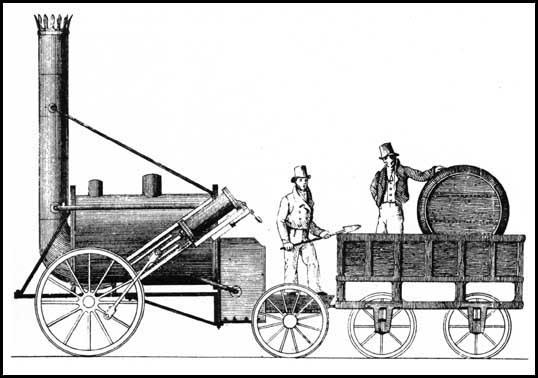The Rocket
In 1824 Edward Pease joined with Michael Longdridge, George Stephenson and his son Robert Stephenson, to form a company to make the locomotives. The Robert Stephenson & Company, at Forth Street, Newcastle-upon-Tyne, became the world's first locomotive builder. The first railway locomotive produced as the works, Locomotion, was finished in September 1825. This locomotive was the main one used on the Stockton & Darlington line was opened on 27th September, 1825.
For the Rainhill Trials in October 1829, the Robert Stephenson entered their new locomotive, the Rocket. Also involved in its production was Henry Booth, the Secretary and Treasurer of the Liverpool & Manchester Railway. It was Booth who suggested using a multi-tubular boiler to produce the necessary steam to drive the locomotive. It was Robert Stephenson's idea to move the cylinders from their traditional vertical position to one inclined at thirty-five degrees. To increase the heating surface, Stephenson replaced the conventional 12 inch diameter iron fire tube with several tubes of 2 inch diameter made of copper. Her cylinders drove on the front pair of wheels and were steeply inclined towards the rear.

Ten locomotives were originally entered for the Rainhill Trials but only five turned up and two of these were withdrawn during the first couple of days of the trials. Sans Pareil and Novelty did well at first but suffered mechanical problems. By the third day the Rocket was the only locomotive left in the competition. That day it covered 35 miles in 3 hours 12 minutes. Hauling 13 tons of loaded wagons, the Rocket averaged over 12 mph. On one trip it reached 25 mph and on a locomotive-only run, 29 mph.
After studying all the evidence, the three judges, John Raistrick, Nicholas Wood and John Kennedy, awarded the £500 first prize to the owners of the Rocket. The contract to produce locomotives for the Liverpool & Manchester Railway went to the Robert Stephenson Company at Newcastle-upon-Tyne.
In 1830 the Rocket was modified. A smokebox was added and the chimney was shortened. The following year the cylinders was reduced from 35 degrees to 8 degrees, which made it a much more steady ride. The modified Rocket worked on the Liverpool & Manchester line until the late 1830s. It was then sold and finished its working life in Carlisle.
Primary Sources
(1) Robert Stephenson explained the design of the rocket in 1838.
By causing all the flame and heated air to pass through a great number of tubes surrounded by water, a very great and rapid means of heating the water is obtained as a very large heated surface is thus exposed to the water.
Former locomotives with only a flue through the boiler have never been able to travel faster than about eight miles an hour as they had not sufficient heating surface in the boiler to generate the steam for supplying the cylinder more rapidly.
The introduction of tubes into the boiler is one of the greatest improvements that has been made in the construction of locomotives, and was the cause of the superiority of the rocket engine to those that competed with it.
(2) (2) The Mechanics Magazine (10th October, 1829)
The engine which made the first trial, was the "Rocket" of Mr. Robert Stephenson (the son, we believe, of Mr. George Stephenson, the engineer of the railway.) lt is a large and strongly-built engine, and went with a velocity, which, as long as the spectators had nothing to contrast it with, they thought surprising enough. It drew a weight of twelve tons, nine cwt. at the rate of ten miles four chains in an hour, (just exceeding the stipulated maximum) and, when the weight was detached from it, went at a speed of about eighteen miles an hour. The faults most perceptible in this engine, were a great inequality in its velocity, and a very partial fulfillment of the condition that it should "effectually consume its own smoke."
(3) The Liverpool Mercury (October, 1829)
We may consider the trial of the Locomotive Engines as now virtually at an end. It is much to be regretted, that "The Novelty" was not built in time to have the same opportunity of exercising that Mr. Stephenson's engine had, or that there is not in London, or its vicinity, any railway where experiments with it could have been tried. It will evidently require several weeks to perfect the working of the machine and the proper fitting of the joints, and under this impression, Messrs. Braithwaite and Ericsson have acted wisely in withdrawing, us they have done, from the contest.
The course is thus left clear for Mr Stephenson; and we congratulate him, with much sincerity, on the probability of his being about to receive the reward of £500. This is due to him for the perfection to which he has brought the old-fashioned locomotive engine, but the grand prize of public opinion is the one which has been gained by Messrs. Braithwaite and Ericsson, for their decided improvement in the arrangement, the safety, simplicity, and the smoothness and steadiness of a locomotive engine; and however imperfect the present works of the machine may be it is beyond a doubt - and we believe we speak the opinion of nine-tenths of the engineers and scientific men now in Liverpool — that it is the principle and arrangement of this London engine which will be followed in the construction of all future locomotives.
